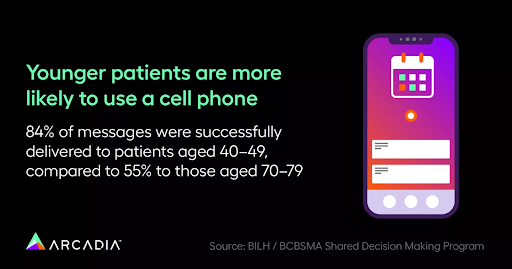Exceptional patient experience is the outcome of several factors working together symbiotically—healthcare organizations and providers, associated tools and technologies, facilities space, and even the patient’s own perceptions and efforts.
However, managing patient outcomes has become more difficult as more providers face burnout from increasing workloads and staffing shortages. Other gaps that disrupt this relationship are caused by inefficient and outdated technologies that can’t keep up with patient demand. These hurdles present real challenges—one study mentions that if a healthcare organization loses one dissatisfied patient, they effectively lose nearly $200,000 in revenue over their lifetime.
So, how can healthcare organizations enhance the patient experience without increasing administrative burdens? Data analytics tools can help care teams achieve this goal by improving the wellness journey across several patient experience domains—access to care, communication, outreach, provider performance, and self-care management. Let’s explore each of these benefits in more detail.
1. Improved access to care
Patient and population data help healthcare providers achieve a more holistic view of the communities they serve.
In the case of outreach, population health data such as social determinants of health (SDoH) leverages socioeconomic factors to improve timely access to care. According to Health.gov, these summarize “the conditions in the environments where people are born, live, learn, work, play, worship, and age” that directly affect an individual’s access to and quality of care. On a ground level, these determinants look like:
- Employment insecurity
- Psychosocial circumstances
- Housing insecurity
- Social adversity
- Transportation
- Food insecurity
- Education and literacy
- Occupational risk
- Economic insecurity
- Emotional support
- Childhood development
- Language
By using this information, providers can access a more comprehensive view to pinpoint at-risk populations and contextualize care based on predefined metrics.
For instance, an organization can provide accessible care resources on its website, launch transportation to target isolated populations, or craft a compelling case for support that advocates for increased government funding. Often, providing relevant, up-to-date data can be a turning point for gathering donations from supporters and other stakeholders.
This way, organizations can benefit from more informed resource management while promoting and fundraising for health equity initiatives.
2. Enhanced communication
When meeting with patients, many providers feel they’re short on time or can’t easily access all the patient data to make the most of each visit. Patients, on the other hand, can also feel overwhelmed when communicating their symptoms and fact-checking their medical records.
Dedicated EHR integration software can solve these communication problems by keeping all clinical and claims data within a centralized location. This enables the patient and provider to efficiently work together to address risk and quality opportunities, care plans, medications, referrals, and other concerns during visits.
It also promotes increased care coordination with organized file management and simplified transferability. This means that the patient, their personal care provider, and other health specialists can participate in informed decision-making to yield improved patient outcomes.
3. Personalized outreach
Data analytics can also enhance communication outside of hospital walls. A study by Arcadia found that younger patients were more likely to respond to cell phone outreach, with patients between the ages 40-49 successfully receiving 84% of messages.

To capitalize on these text messaging benefits, organizations can use AI-enabled tools to segment patient populations and send personalized messaging without high-touch demand from care managers. Here are some personalized messages organizations can send to meet various patient purposes:
- Appointment reminders: “Rebecca, don’t forget your appointment with Dr. Smith tomorrow at 10 AM at [Clinic Name]. Reply ‘C’ to confirm or ‘R’ to reschedule.”
- Preventative care: “James, we’re here to help protect your health! It’s time for your annual flu shot. Call [Clinic Name] at [Phone Number] to schedule your vaccination.”
- Billing and payment reminders: “Hilary, your recent healthcare bill of $XX is due on [Due Date]. You can pay online at [Payment Portal Link].”
- Specialist referral confirmation: “Ben, good news! Your referral to Dr. Johnson for [Specialty] has been approved. We’ll call on [Date] with appointment details.”
Sending automated appointment reminders, personalized health messages, and other administrative reminders are all ways organizations can use analytics-based outreach to meet individual patient needs. Additionally, organizations can send out a post-visit SDoH survey to gather feedback to adjust patient information and improve retention.
4. Improved provider performance
Healthcare provider performance directly impacts patient experience. Timely, informed, and compassionate care plays a major role in a patient’s road to recovery. That said, in order to keep readmission rates and waiting times low, organizations need a reliable way to measure internal provider performance.
Data-based healthcare dashboards can provide an accessible view of a care team’s real-time operational performance against target metrics. With these tools in hand, organizations can equip providers with comprehensive performance reports and scorecards that offer actionable feedback.
Additional tabs can provide a window into other relevant entities such as primary care provider payers to streamline administrative tasks. From these metrics, you can formulate actionable fiscal and administrative recommendations for an enhanced patient experience.
5. Patient self-care empowerment
A remarkable outcome of data analytics is the ability for patients to take a more active role in their healthcare journeys. With more personalized insights, patients can feel confident that their relationship with their provider will yield tangible health results.
Shared decision-making can lead to more proactive healthcare prevention solutions that empower patients to take control of their health through daily habit adjustments and automated health reminders. Additionally, engagement tools such as real-time health goal tracking, interactive health assessments, and health chatbots enable patients to problem-solve and feel more prepared for their next appointment.
Positive patient experience is a collaborative effort between healthcare technology, care teams, and patients. Data analytics can help these parties work together to achieve a higher value of care without sacrificing additional resources. This, in turn, expands meaningful patient care and elevates ROI.
